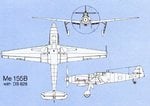davebender
1st Lieutenant
Blohm Voss BV 155 - Wikipedia, the free encyclopedia
During 1942 Messerschmitt designed the Me-155 for use on German aircraft carriers. Supposedly the design was complete by September 1942, just in time to be cancelled along with the German CV program.
1 x 1,475 hp DB605 engine.
Wide track landing gear.
3 x MG151/20 cannon. Prop shaft plus 1 in each wing.
403 mph estimated max speed.
Messerschmitt Me 209-II - Wikipedia, the free encyclopedia
During 1943 Messerschmitt designed the Me-209 II as a replacement for the Me-109 series. This aircraft was powered by a DB603 engine. The shortage of DB603 engines was probably the major factor why the Me-209 II did not superceed the Me-109.
Why didn't the Luftwaffe select the Me-155 as a replacement for the aging Me-109 series starting in 1943? There were plenty of DB605 engines available.
During 1942 Messerschmitt designed the Me-155 for use on German aircraft carriers. Supposedly the design was complete by September 1942, just in time to be cancelled along with the German CV program.
1 x 1,475 hp DB605 engine.
Wide track landing gear.
3 x MG151/20 cannon. Prop shaft plus 1 in each wing.
403 mph estimated max speed.
Messerschmitt Me 209-II - Wikipedia, the free encyclopedia
During 1943 Messerschmitt designed the Me-209 II as a replacement for the Me-109 series. This aircraft was powered by a DB603 engine. The shortage of DB603 engines was probably the major factor why the Me-209 II did not superceed the Me-109.
Why didn't the Luftwaffe select the Me-155 as a replacement for the aging Me-109 series starting in 1943? There were plenty of DB605 engines available.





